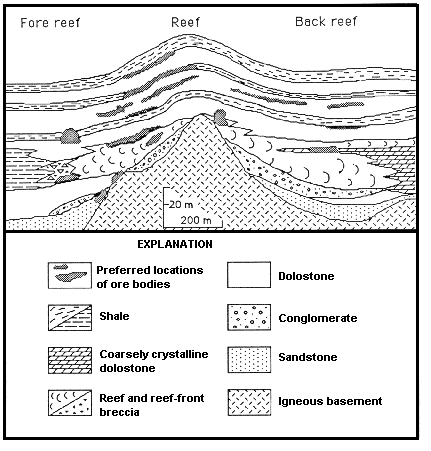
DESCRIPTIVE MODEL OF SOUTHEAST MISSOURI Pb-Zn
MODEL 32a
By Joseph A. Briskey
SYNONYMS Carbonate-hosted Pb-Zn; Mississippi Valley type.
DESCRIPTION Stratabound, carbonate-hosted deposits of galena, sphalerite, and chalcopyrite in rocks having primary and secondary porosity, commonly related to reefs on paleotopographic highs (see fig. 166). (For grade-tonnage model see Appalachian Zn deposit model.)
Figure 166. Cartoon cross section of a southeast Missouri Pb-Zn deposit (modified from Evans, 1977).

GENERAL REFERENCES Snyder and Gerdemann (1968), Thacker and Anderson (1977).
GEOLOGICAL ENVIRONMENT
Rock Types Dolomite; locally ore bodies also occur in sandstone, conglomerate, and calcareous shales.
Textures Calcarenites are most common lithology. Tidalites, stromatolite finger reefs, reef breccias, slump breccias; oolites, crossbedding, micrites.
Age Range Known deposits are in Cambrian to Lower Ordovician strata.
Depositional Environment Host rocks are shallow-water marine carbonates, with prominent facies control by reefs growing on flanks of paleotopographic basement highs. Deposits commonly occur at margins of clastic basins.
Tectonic Setting(s) Stable cratonic platform.
Associated Deposit Types Precambrian volcanic-hosted magnetite; Ba-Pb deposits occur higher in the Cambrian section.
DEPOSIT DESCRIPTION
Mineralogy Galena, sphalerite, chalcopyrite, pyrite, marcasite. Minor siegenite, bornite, tennantite, barite, bravoite, digenite, covellite, arsenopyrite, fletcherite, adularia, pyrrhotite, magnetite, millerite, polydymite, vaesite, djurleite, chalcocite, anilite, and enargite in order of abundance. Dolomite and minor quartz.
Texture/Structure Early fine-grained replacement; main stage coarse-grained replacement and vuggy or colloform open space filling. Hypogene leaching of galena is common.
Alteration Regional dolomitization; latter brown, ferroan, and bitumen-rich dolomite; extensive carbonate dissolution and development of residual shale; mixed-layer illite-chlorite altered to 2M muscovite; dickite and kaolinite in vugs; very minor adularia.
Ore Controls Open-space filling and replacement, most commonly at the interface between gray and tan dolomite, but also in traps at any interface between permeable and impermeable units. Any porous units may host ore: sandstone pinchouts; dissolution collapse breccias; faults; permeable
reefs; slump, reef, and fault breccias; coarsely crystalline dolostone.
Geochemical Signature Regional anomalous amounts of Pb, Zn, Cu, Mo, Ag, Co, and Ni in insoluble residues. Zoning is roughly Cu (± Ni ± Co)-Pb-Zn-iron sulfide going up section; ores contain about 30 ppm Ag; inconsistent lateral separation of metal zones. Background for carbonates: Pb = 9 ppm; Zn = 20; Cu = 4.
EXAMPLES
Viburnum subdistrict, USMO (Economic Geology 1977; Heyl, 1982)